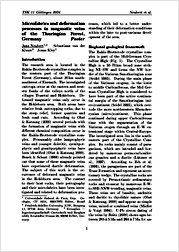Microfabrics and deformation processes in magmatic veins of the Thuringian Forest, Germany
2006Universitätsverlag Göttingen
Sammelband- / Konferenzbeitrag
Verlagsversion
Deutsch
Neubert, Jana; Klauw, Sebastiaan van der; Kley, Jonas, 2006: Microfabrics and deformation processes in magmatic veins of the Thuringian Forest, Germany. In: Philipp, S.; Leiss, B; Vollbrecht, A.; Tanner, D.; Gudmundsson, A. (eds.): 11. Symposium "Tektonik, Struktur- und Kristallingeologie"; 2006, Univ.-Verl. Göttingen, p. 146 - 151., , DOI: 10.23689/fidgeo-1828.
 |
Dokument öffnen: |
The research area is located in the
Ruhla-Brotterode crystalline complex in the western part of the Thuringian
Forest (Germany), about 20km southsouthwest
of Eisenach. The investigated
outcrops occur at the eastern and western
flanks of the valleys north of the
villages Trusetal and Hohleborn. Deformed
magmatic veins only occur in
the Hohleborn area. Both areas have
relative fresh outcropping rocks, due to
the steep relief, former quarries and
fresh road cuts. According to Obst
& Katzung (2000) several periods with
the formation of magmatic veins with
different chemical composition occur in
the Ruhla-Brotterode crystalline complex.
Presumably older lamprophyric
veins and younger doleritic, syenitporphyric
and granitporphyric veins have
been identified (Obst & Katzung 2000).
Benek & Schust (1988) already pointed
out that some of these magmatic veins
have experienced ductile deformation.
The subject of this work is the occurrence
of deformed magmatic veins
in the Hohleborn area. The contact
to their host rocks, their petrography
and their microfabrics have been investigated
and related to deformation processes,
which led to a better understanding
of their deformation conditions
within the late-to post-variscan development
of the area.

